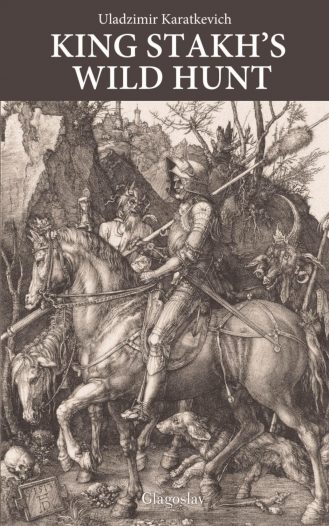 By ULASZIMIR KARATKIEVIC (https://knihi.com/Uladzimir_Karatkievic/King_Stachs_Wild_Hunt-eng.html#chapter1; 1964)
By ULASZIMIR KARATKIEVIC (https://knihi.com/Uladzimir_Karatkievic/King_Stachs_Wild_Hunt-eng.html#chapter1; 1964)
Don’t you hate it when an apparent supernatural thriller cops out by explaining away its horrors with a rational explanation? That’s the case with this novel, apparently the most popular by Belarussian author Uladzimir Karatkievic (1930-1984). It was adapted for a 1979 film.
The novel has an arresting concept concerning a remote region of Belorussia haunted, apparently, by the vengeful apparitions of the late King Stach, who was murdered by the powerful magnate Raman Janouski back in the 17th Century. Upon his death Stach swore eternal vengeance against the entire Janouski line, and since then the King apparently rampages through the area each night together with twenty of his subordinates, all riding ghostly horses. Also haunting the area is an odd froglike man whose appearance portends death and a mysterious woman in blue.
The first person protagonist is Bielarecki, a young man on an expedition in the forbidding “District N.” He takes refuge in the first abode he comes to, which turns out to belong to the once-proud clan descended from the evil Raman Janouski. Now only one Janouski remains, the winsome 18-year-old Janouskaja. She’s terrified of King Stach and his hunters, who are seemingly intent on doing her in. Bielarecki ends up staying with Janouskaja far longer than he initially planned, and of course falls in love with her in the process.
This covers roughly the first third of the novel, which frankly isn’t too exciting. The prose is rich and descriptive, but it suffers from an overly snooty protagonist whose constant bitching about the lack of class displayed by District N’s peasant populace grows irritating very quickly. A familiarity with Belorussian politics and customs is also required to fully understand the many pointed observations about things like “the pine needles in the teapot, the smoky, black huts where the women in their warm, long skirts made of homespun material, sing their song, an endless song more like a groan…”
However, once King Stach and his spectral goons enter the tale things pick up—as the protagonist acknowledges halfway through, “If my story has formerly been somewhat slow in its development, it will now very likely be too swift.” Too swift is a bit of an overstatement, but the novel gains considerable momentum as Stach and the gang step up their attacks and Bielarecki takes steps to bring the hunters down, eventually organizing District N’s cowed peasants into a climactic SEVEN SAMURAI-like offensive against the ghouls.
Unfortunately it’s here that the novel falls apart in the agonizingly logical conclusion. All the scary business—the frog-man, the hunters, the woman in blue—is laboriously (and unconvincingly) explained away in time for the expected happy ending. Don’t get too complacent, though, as Bielarecki concludes his account with the observation that “its time is not yet over, not as long as gloom and darkness and cold, social inequality and dark horror exist on earth. Across the land, half drowned in fog, still clashes The Wild Hunt.” Until, that is, somebody manages to explain it away.
